This week I’m going to report on the Medway History Showcase and the first three of the lunchtime lectures, organised by Dr Claire Bartram, as part of Canterbury Festival, but will just mention here that Dr Diane Heath was one of the presenters at the ‘Social and Environmental Justice for a Sustainable Future’ conference at CCCU on Tuesday, I had good weather for my Canterbury Festival walk on ‘Everyday life in Late Medieval Canterbury’ last Sunday and I had a good meeting on Wednesday with Dr Sarah James, the project leader for the St Dunstan’s church ‘Big Plan’ project, and Professor Catherine Richardson, Dr Rory Loughnane, Dr Emily Guerry and Dr David Rundle from Kent concerning potential student engagement with the project.
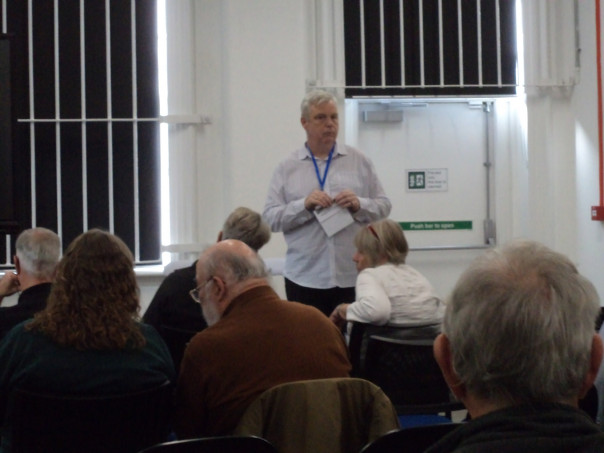
Starting with the Medway History Showcase last Saturday, which was organised by Peter Joyce, who had taken over managing this from Professor Mark Connelly (University of Kent) as part of the IHR Centenary. Working with the staff at the Royal Engineers Museum, Gillingham, Peter had created an excellent programme of talks for the day, and over a dozen exhibitors had stalls on the ground floor section of the museum. As well as being backed by Kent Archaeological Society, CKHH was also involved and we had on show two projects the Centre is involved in, as well as providing one of the talks. Thus, as you can see here, Diane Heath’s ‘Medieval Animals Heritage’ project drew lots of admirers and more people voted for naming the ‘Green Dragon’. Moreover, Diane was able to recruit several people who volunteered to visit Kent medieval churches and then send her photos of animals they spot there, whether in the stained glass, on the font, as carvings in the roof etc. This will help Diane to construct her animal safaris, a sort-of i-spy medieval animals as a way of exploring for SEND children and their families. You may remember this was one of the activities Diane and her team did with the children as part of the Becket Play week in St Clement’s church, Sandwich, which was reported in the blog: https://blogs.canterbury.ac.uk/kenthistory/exploring-kents-history-and-having-fun/ .
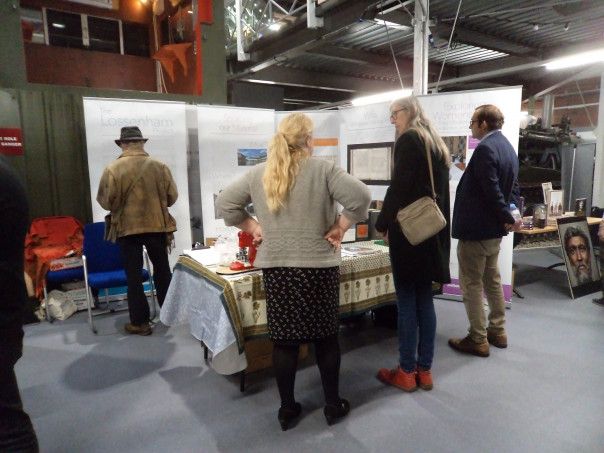
The other project we decided to showcase at Gillingham was the Lossenham Project and Jason Mazzocchi, who is doing a history doctorate at CCCU, showed visitors to the exhibition how the volunteers on the project have been deploying wills to gain an understanding of life on the Rother Levels in the early modern period. Consequently, we had five of the exhibition banners from the September Lossenham Priory Study Day that highlight the archives where these primary sources are held, matters relating to handwriting and the various abbreviations and other conventions used by clerks, as well as the potential of such sources to provide a window on past lives, including those who often do not appear in archival sources – women. Again, this sparked considerable interest and Jason talked to a steady stream of people in the gaps between the talks which took place in a room nearby.
Pete had wanted at least some of the talks to be Medway (west Kent) centric, consequently I spoke on Medway’s medieval hospitals. However, because I wanted to bring in the four types of medieval hospital: those for lepers, for poor pilgrims, for the poor and infirm, and the late medieval almshouse in its two forms, I adapted the title he had given me from Medway to the Medway valley in order to bring in Maidstone, with just a brief mention of Tonbridge because the latter only had a late medieval almshouse.
Taking the Medway area of Rochester, Chatham and Strood, I brought in the early leper hospital dedicated to St Bartholomew outside Rochester’s city wall in Chatham founded in the late 11th century by Bishop Gundulf, which incidentally also housed the poor and infirm. Incidentally, this is a good way to highlight the point that the medieval provision for lepers should be seen as separation not isolation. The second leper hospital of St Nicholas by the White Ditch at Strood, so the other side of Rochester and the third, unusually late foundation by Simon Potyn whose early 14th-century leper hospital dedicated to St Catherine was in the Eastgate suburb of Rochester.

For the poor and infirm, we have already had some provision at St Bartholomew’s, but here I talked briefly about St Peter and St Paul’s hospital at Maidstone. The archiepiscopal foundation housed a priest and ten poor people, but like many hospitals experienced hard times in the 14th century and was refounded as a college by Archbishop Courtney in 1395, albeit some provision for poor people was retained.

My example for poor pilgrims was the episcopal foundation of St Mary’s hospital, located on the Strood side of the Medway next to the old Rochester bridge. For as well as presumably accommodating poor pilgrims overnight, the chapel of St Mary was a place where travellers could give thanks for a safe crossing, or before they set out due to the notorious state of this ancient bridge. Incidentally, while the new late 14th-century bridge nearby was a major improvement for those crossing, it was far less help to the hospital because the new bridge chapel belonging to the Bridge Wardens was next to the new bridge on the Rochester side.
Drawing on the work of Dr Paul Lee, although Rochester had ‘Le Almeshouse’ in the city, it is somewhat of a shadowy institution and going back to Maidstone there was the almshouse attached to the Corpus Christi Fraternity that might also be seen as a pseudo-civic organisation, the town coming under the jurisdiction of the archbishop’s manor of Maidstone. Maidstone also had from the will evidence ‘a hospital on the bridge’ but this is another of these shadowy hospitals.
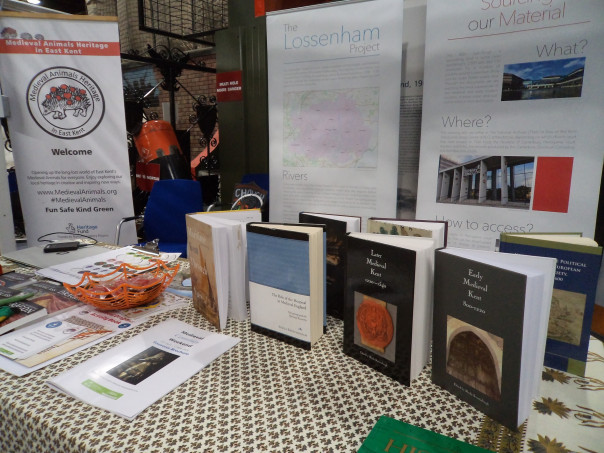
I was not the only speaker from CCCU, and Professor Carolyn Oulton and Dr Martin Watts also gave talks. As they are also giving Canterbury Festival ‘lunchtime lectures’ on their respective topics, I’ll mention them in that context, Carolyn this week and Martin next. Also present at Gillingham was Michelle Crowther, university librarian, who with Carolyn was displaying the CCCU ‘Kent Maps Project’.
Now moving to Claire’s Festival ‘lunchtime lectures’, on Monday this week we gathered in St Paul’s church, thanks to the Revd Mark Griffin, for Dr John Bulaitis’ talk on the ‘Kentish Tithe Wars’. John decided to adopt a more informal approach by explaining to his audience how and why he had become interested in tithe after moving to Shepherdswell twelve years ago and discovering that in September 1934 a local farm had hit the national headlines. The Evening Standard’s deadline ‘Tithe Battle of the Ducks’ referred to an incident at West Court Farm when a group of about a hundred people, many from the Tithe Payers’ Association, had ‘liberated’ livestock previously seized from the Revd Roderick Kedward’s farm at Westwell for non-payment of tithe. As John said, the ducks were not the only livestock that had been seized but they were easier to ‘reclaim’ compared to the bull! The event deeply upset those in the Home Office who saw it as a dangerous precedent and 25 policemen were sent to the Shepherdswell farm to ensure there were no further incidents.
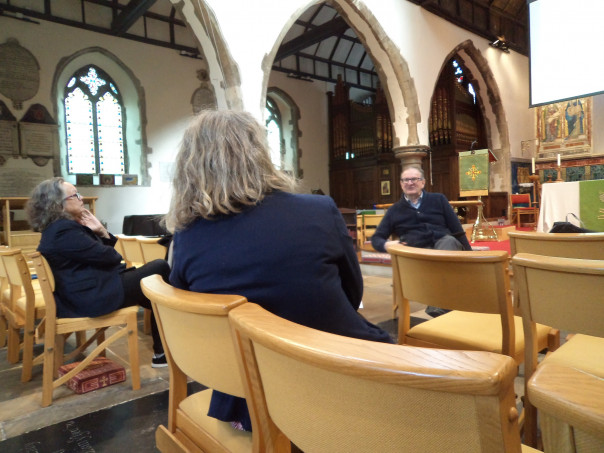
Taking this as his way in, John then went back in time to mention briefly the early history of tithe, the tensions that it had produced over the centuries, citing Dr Paula Simpson’s research on the diocese of Canterbury in the 16th century. He then moved to the 19th century, especially the 1830s and 1880s, demonstrating that Kent, although not the only region in England and Wales where tithe was a burning issue, had seen a considerable number and range of actions taken against tithe collectors and others involved in the process. As he said, the various parliamentary acts did not resolve the issue and the early 1930s, as a time of agricultural depression, saw further outbreaks of dissent, including the duck incident. Indeed, tithe was not finally abolished for another forty years. John’s talk sparked several questions from the audience, and I think this bodes well for John’s book on the topic which will be published next year.
On Tuesday we were back in St Paul’s church, thanks Mark, for Professor Carolyn Oulton’s talk on seaside reading in the Victorian period. Her talk drew on her recent book, as well as her chapter in Maritime Kent through the Ages, where she explores how the coming of the railways down to the coast meant that Londoners in the 1860s went on holiday – to places from Thanet round to Brighton and Eastbourne – and enjoyed reading on the train and while staying at the seaside. These books were cheap, something that could be picked up at Smiths at the railway station and then consumed on the way down to the resort and finished either at the resort or on the journey home. The idea being that they should be pacey (and often racy), matching the train journey as you sped through the Kent countryside, the topics covered including bigamy and murder, as well as romance or ‘husband-hunting’. Although not exclusively aimed at young women, the idea of a flirtatious time at the seaside was seen as part of the appeal, perhaps mirroring the storyline but equally there was the understanding that dangerous temptations might trap the unwary young lady.
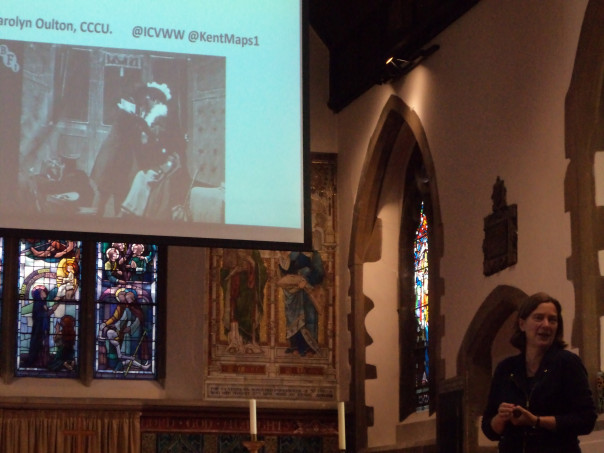
Carolyn went on to talk about other book series, such as those involving Mrs Brown, who as ‘a lovable Cockney’ offered a working-class character who was wise and was able to bring a touch of satire to the various occasions she experienced at different resorts. Nor was she the only character who developed at this time because the idea of the flashy ‘Del-boy’ and his wife – ‘Arry and ‘At – were similarly part of the host of people one might meet at the seaside. However, alongside the fiction there were cartoons, Punch, in particular, seeing such scenarios as food for a variety of depictions.
For her final section, Carolyn looked at seaside guides, another form of literature that could be used by producers to differentiate ‘their’ resort from others and thus the type of visitors they wished to attract. Although there were seen to be differences within the Isle of Thanet itself, there was also the desire by those from Folkestone to distance themselves from Margate, presenting a more genteel picture of the attractions to be found by discerning visitors to the town, who would promenade on the Leas. All of this sparked quite a discussion afterwards, making this a second great talk at St Paul’s church.

On Wednesday we moved to the university campus and Michelle Crowther gave us a talk on the ‘Persistent Scribblers’, members of the Victorian cathedral community and their families, who wrote short stories and poetry regularly for the benefit of the group within a somewhat competitive environment. This group is the subject of Michelle’s doctorate and for this presentation she looked at their literary efforts on two themes: heroism within the context of the Franco-Prussian War and the role and experiences of ‘lady-helps’ – genteel companions who having fallen on hard times needed employment that befitted their social standing. I have reported on this second topic of Michelle’s in the blog before, so will keep to her first topic this time.
As Michelle said, the ‘Persistent Scribblers’ took up this theme in several ways, in part responding to current ideas such as the fear that the British Army of the day was not as professional as it should be and that the link between the public school system and the officer class meant money rather than merit was the order of the day. The need for reform was something the writers favoured and one way of portraying this was by writing about the ordinary soldiers, giving them dignity in death and the surety of a Christian afterlife. Moreover, while initially during this war the Prussians had been favoured nationally, as the war went on opinions began to shift, and one of the ‘Scribblers’ had as her hero an ordinary French soldier. Nonetheless, there was a belief that war was part of God’s plan for Mankind, giving opportunities for heroic Christianity, albeit others questioned whether the common soldier was let down by his superiors. Additionally, some writers sought to portray such heroism within war from a female standpoint, including the hero’s sweetheart who had been left behind. Another aspect was the ‘golden deed’, the idea of linking heroism to sacrifice and the greatest gift of any man being to save another at the expense of his own life. Again, some of the ‘Scribblers’ gave a female focus to such a narrative. King Arthur, too, was not forgotten within these ‘Scribbler’ narratives, and the idea of the chivalric knight was an important motif, even in the hands of women as the heroine through a dream sequence sees herself as a knight errant, thereby controlling her own destiny.
Thus, we had another very interesting talk, and it is amazing how Michelle finds time to do her doctorate at the same time as undertaking a very demanding and diverse job within the university library. So, thanks very much to our first three speakers and I just want to mention that it will be Dr Maria Diemling on Thursday, same time of 1pm in the university chapel, and then on Friday back in the Old Sessions lecture theatre for Dr Martin Watts. All welcome and it will be great to see staff, students and members of the public at these sessions.
 Centre for Kent History and Heritage
Centre for Kent History and Heritage Sheila Sweetinburgh
Sheila Sweetinburgh 1552
1552

